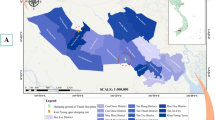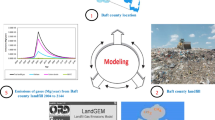Abstract
Landfills are substantial anthropogenic sources of greenhouse gases such as methane (CH4), carbon dioxide (CO2), and non-methane volatile organic compounds (NMVOCs). This study reports a simple and efficient method for determining the environmental loads of landfill gases (LFG) emitted from the Nam Binh Duong landfill, Vietnam, by applying the LandGEM and the IPCC first-order decay models (FOD model). The environmental LFGs loads were quantified based on both the relevant parameters of the generation potential (L0) of 81 m3/Mg and the generation rate (k) of 0.355 year−1 of methane (CH4) as well as the average measurement value of CH4 (57% by volume of the LFGs) obtained throughout the on-site measurements of the investigated landfill (Scenario 1). Then, the quantified emission results of the LFGs were compared to those of the Clean Air Act (CAA) default mode of the model (Scenario 2). During the period from 2004 to 2144, the projected landfill methane emissions add up to 116,377 t of CH4 with an average of 825 t of CH4/year. The paired t test conducted to compare the gas emissions obtained from both scenarios demonstrated that the on-site parameters significantly affect the yield of the LFGs. The estimated total LFG, methane, CO2, and NMVOCs recovery potential can serve as supporting data for policy making on obtaining renewable energy from landfills and minimizing the environmental issues caused by LFGs emissions.






Similar content being viewed by others
Data availability
All data generated or analyzed during this study are included in this published article (and its supplementary information files).
References
Kamalan H, Sabour M, Shariatmadari N (2011) A review on available landfill gas models. J Environ Sci Technol 4:79–92
Du M, Peng C, Wang X et al (2017) Quantification of methane emissions from municipal solid waste landfills in China during the past decade. Renew Sust Energ Rev 78:272–279. https://doi.org/10.1016/j.rser.2017.04.082
Rajaram V, Siddiqui FZ, Emran Khan M (2011) From landfill gas to energy. CRC Press, London
Machado SL, Carvalho MF, Gourc JP, Vilar OM, do Nascimento JCF (2009) Methane generation in tropical landfills: simplified methods and field results. Waste Manag 29:153–161. https://doi.org/10.1016/j.wasman.2008.02.017
Cheremisinoff NP (2003) Handbook of solid waste management and waste minimization technologies. Elsevier Science (USA)
Myhre G, Shindell D, Bréon F-M et al (2013) Anthropogenic and natural radiative forcing. In: Intergovernmental Panel on Climate Change (ed) Climate Change 2013 - The Physical Science Basis. Cambridge University Press, Cambridge, pp 659–740
Thompson S, Sawyer J, Bonam R, Valdivia JE (2009) Building a better methane generation model: validating models with methane recovery rates from 35 Canadian landfills. Waste Manag 29:2085–2091. https://doi.org/10.1016/j.wasman.2009.02.004
Vogt WG, Augenstein D (1997) Comparison of models for predicting landfill methane recovery. Final report, Virginia
Boyle WC (1977) Energy recovery from sanitary landfills - a review. Microb Energy Convers:119–138. https://doi.org/10.1016/B978-0-08-021791-8.50019-6
Zhu H, Letzel MO, Reiser M, Kranert M, Bächlin W, Flassak T (2013) A new approach to estimation of methane emission rates from landfills. Waste Manag 33:2713–2719. https://doi.org/10.1016/j.wasman.2013.08.027
Ishii K, Furuichi T (2013) Estimation of methane emission rate changes using age-defined waste in a landfill site. Waste Manag 33:1861–1869. https://doi.org/10.1016/j.wasman.2013.05.011
Ishigaki T, Van Chung C, Sang NN et al (2008) Estimation and field measurement of methane emission from waste landfills in Hanoi, Vietnam. J Mater Cycles Waste Manag 10:165–172. https://doi.org/10.1007/s10163-008-0202-8
Abichou T, Clark J, Tan S, Chanton J, Hater G, Green R, Goldsmith D, Barlaz MA, Swan N (2010) Uncertainties associated with the use of optical remote sensing technique to estimate surface emissions in landfill applications. J Air Waste Manage Assoc 60:460–470. https://doi.org/10.3155/1047-3289.60.4.460
Faour AA, Reinhart DR, You H (2007) First-order kinetic gas generation model parameters for wet landfills. Waste Manag 27:946–953. https://doi.org/10.1016/j.wasman.2006.05.007
Ozkaya B, Demir A, Bilgili MS (2007) Neural network prediction model for the methane fraction in biogas from field-scale landfill bioreactors. Environ Model Softw 22:815–822. https://doi.org/10.1016/j.envsoft.2006.03.004
Malakahmad A, Abualqumboz MS, Kutty SRM, Abunama TJ (2017) Assessment of carbon footprint emissions and environmental concerns of solid waste treatment and disposal techniques; case study of Malaysia. Waste Manag 70:282–292. https://doi.org/10.1016/j.wasman.2017.08.044
Kormi T, Bel Hadj Ali N, Abichou T, Green R (2017) Estimation of landfill methane emissions using stochastic search methods. Atmos Pollut Res 8:597–605. https://doi.org/10.1016/j.apr.2016.12.020
Karanjekar RV, Bhatt A, Altouqui S, Jangikhatoonabad N, Durai V, Sattler ML, Hossain MDS, Chen V (2015) Estimating methane emissions from landfills based on rainfall, ambient temperature, and waste composition: the CLEEN model. Waste Manag 46:389–398. https://doi.org/10.1016/j.wasman.2015.07.030
Mou Z, Scheutz C, Kjeldsen P (2020) Evaluation and application of site-speci fi c data to revise the fi rst-order decay model for estimating land fill gas generation and emissions at Danish landfills. 65:686–698. https://doi.org/10.1080/10962247.2015.1008653
Alexander A, Burklin C, Singleton A (2005) Landfill gas emissions model (LandGEM) Version 3.02 User’s Guide. 56
Srivastava AN, Chakma S (2020) Quantification of landfill gas generation and energy recovery estimation from the municipal solid waste landfill sites of Delhi, India. Energy Sources A Recover Util Environ Eff 00:1–14. https://doi.org/10.1080/15567036.2020.1754970
Pipatti R, Svardal P, Coburn JBB et al (2006) 2006 IPCC Guidelines for national greenhouse gas inventories. Japan on behalf of the IPCC, Hayama
Eun S, Reinhart DR, Cooper CD, Townsend TG, Faour A (2007) Hydrogen sulfide flux measurements from construction and demolition debris (C&D) landfills. Waste Manag 27:220–227. https://doi.org/10.1016/j.wasman.2005.12.019
Amini HR, Reinhart DR, Mackie KR (2012) Determination of first-order landfill gas modeling parameters and uncertainties. Waste Manag 32:305–316. https://doi.org/10.1016/j.wasman.2011.09.021
Myhre G, Shindell D, Bréon F-M, et al (2013) Anthropogenic and natural radiative forcing
Vu HL, Ng KTW, Richter A (2017) Optimization of first order decay gas generation model parameters for landfills located in cold semi-arid climates. Waste Manag 69:315–324. https://doi.org/10.1016/j.wasman.2017.08.028
Abushammala MFMFM, Basri NEAEA, Kadhum AAHAH et al (2014) Evaluation of methane generation rate and potential from selected landfills in Malaysia. Int J Environ Sci Technol 11:377–384. https://doi.org/10.1007/s13762-013-0197-0
Stege CA, Murray DL, Stege GA, Davila JL (2009) User’s Manual Mexico Landfill Gas Model Version 2.0
Siliezar C, Urquizo R (2009) User’s Manual Ecuador Landfill Gas Model Version 1.0
Ludwig V, Stege GA, Murray DL (2007) User’s Manual Central America Landfill Gas Model. 1–26
Burklin C (2009) User’s Manual China Landfill Gas Model, EP-W-06-022
Khoi VDN (2014) Research on methane generation calculating at Khanh Son landfill to the year 2030 Danang city,Vietnam (In Vietnamese). Da Nang University
Schneider P, Anh LH, Wagner J, Reichenbach J, Hebner A (2017) Solid waste management in Ho Chi Minh City, Vietnam: moving towards a circular economy? Sustain 9:1–20. https://doi.org/10.3390/su9020286
Tuan TN, Diep TTA (2014) Assessment of CO2e emission reduction of solid waste composting versus landfilling at in Hue city (in Vietnamese). J Sci Technol Hue Uuniv Sci 1:143
Miyazawa M, Pavan MA, de Oliveira EL et al (2000) Gravimetric determination of soil organic matter. Braz Arch Biol Technol 43:475–478. https://doi.org/10.1590/S1516-89132000000500005
Rao MNN, Sultana R, Kota SH (2017) SOLID AND HAZARDOUS WASTE MANAGEMENT Science and Engineering British Library Cataloguing-in-Publication Data. Joe Hayton
Wangyao K, Yamada M (2010) Methane generation rate constant in tropical landfill. J Sustain Energy Environ 1:181–184
Mou Z, Scheutz C, Kjeldsen P (2015) Evaluating the methane generation rate constant (k value) of low-organic waste at Danish landfills. Waste Manag 35:170–176. https://doi.org/10.1016/j.wasman.2014.10.003
IPCC (2014) Climate Change 2014: Synthesis Report. Geneva, Switzerland
Funding
This work was supported by the Korea Institute for Advanced of Technology (KIAT) grant funded by the Korea Government (MOTIE) (P0008421, 2020 The Company Development Program for Industry Specialist).
Author information
Authors and Affiliations
Contributions
Le Hung Anh: writing—original draft; methodology. Nguyen Thi Thanh Truc: supervision; writing—review and editing; investigation. Nguyen Thi Khanh Tuyen: writing—review and editing; investigation; writing—original draft. Ho Quoc Bang and Nguyen Phong Son: data curation and formal analysis. Petra Schneider: investigation, data curation, review, and editing. Byeong-Kyu Lee: supervision and project administration. Konstantinos Moustakas: resources, software, and validation. All authors read and approved the final manuscript.
Corresponding authors
Ethics declarations
Ethics approval and consent to participate
Not applicable
Consent for publication
Not applicable
Additional information
Publisher’s note
Springer Nature remains neutral with regard to jurisdictional claims in published maps and institutional affiliations.
Supplementary Information
ESM 1
(DOCX 249 kb)
Rights and permissions
About this article
Cite this article
Anh, L.H., Thanh Truc, N., Tuyen, N.T.K. et al. Site-specific determination of methane generation potential and estimation of landfill gas emissions from municipal solid waste landfill: a case study in Nam Binh Duong, Vietnam. Biomass Conv. Bioref. 12, 3491–3502 (2022). https://doi.org/10.1007/s13399-020-01192-0
Received:
Revised:
Accepted:
Published:
Issue Date:
DOI: https://doi.org/10.1007/s13399-020-01192-0




